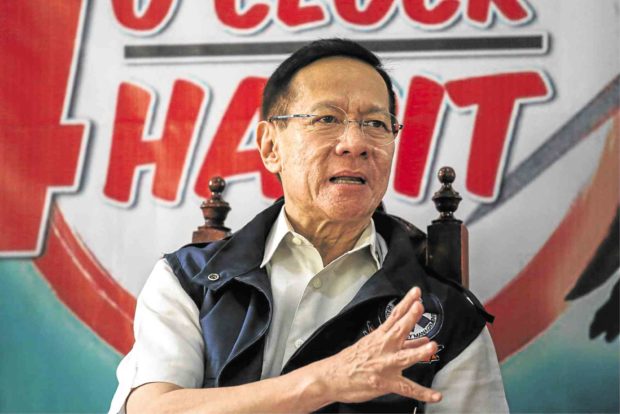DOH urges polio shots; virus detected in sewage
MANILA, Philippines — The Department of Health (DOH) on Saturday appealed to parents to have their children vaccinated against polio, after a test on Manila’s sewage showed the existence of the virus that causes the debilitating disease.
Health Secretary Francisco Duque III said a recent sampling of Manila’s sewage tested positive for the vaccine-derived poliovirus (VDPV), which the World Health Organization (WHO) defined in its website as “an excreted vaccine-virus that can continue to circulate for an extended period of time.”
No transmissions yet
“The longer it is allowed to survive, the more genetic changes it undergoes. In very rare instances, the vaccine-virus can genetically change into a form that can paralyze — this is what is known as a circulating vaccine-derived poliovirus (cVDPV),” WHO said in its website (who.int/features/qa/64/en/).
Duque said that while there are no recorded transmissions yet, parents should ensure that their children are protected since the virus is already in the environment.
Article continues after this advertisement“We repeat our call to parents and caregivers: Let us prioritize the complete vaccination of our children so they remain safe from vaccine-preventable diseases, like polio,” the health secretary said at a press conference.
Article continues after this advertisement“We need to make sure that the polio vaccine coverage should be at 95 percent to ensure that this will not create problems to our children,” Duque said.
There is no cure for the disease, he added.
“Complete vaccination is the best way to prevent it,” he said.
The Philippines since 2016 has been falling short of the ideal immunization coverage rate of 95 percent. Coverage was at 68 percent in 2016, increasing slightly to 71 percent the next year, but dropping again to 66 percent in 2018.
A fatal and disabling disease, polio is transmitted through the fecal-oral route, especially where there’s poor personal hygiene and environmental sanitation. It mostly affects children below 15.
Polio-free since 2000
Apart from the latest disclosure by Duque, the Philippines has been certified polio-free since 2000 by the DOH.
Given that VDPV was found in the city of Manila, Duque called on local governments to intensify the implementation of their zero open-defecation program as well as to strengthen their efforts to ensure good personal hygiene and sanitation.
The US Centers for Disease Control and Prevention described VDPV as a “strain of the weakened poliovirus that was initially included in oral polio vaccine (OPV) and that has changed over time and behaves more like the wild or naturally occurring virus.”
“This means it can be spread more easily to people who are unvaccinated against polio and who come in contact with the stool or respiratory secretions, such as from a sneeze, of an infected person,” the CDC said.
Given that sewage usually end up in Manila Bay, Duque said it “remains unsafe for swimming.”
As part of its efforts to ensure that no child is left unvaccinated, the DOH is currently conducting an immunization drive for polio aimed at covering 5.5 million children in the National Capital Region, Central Luzon and Calabarzon.
“The vaccination is free and will be administered by giving a child two drops of OPV by mouth. OPV has been used in the country since 1980,” Duque said.
